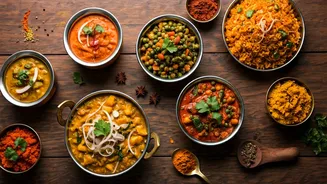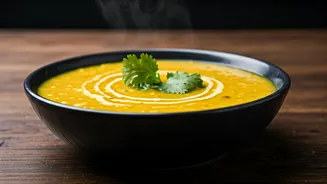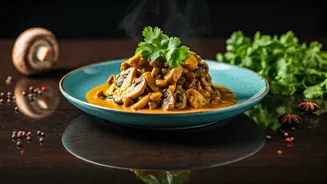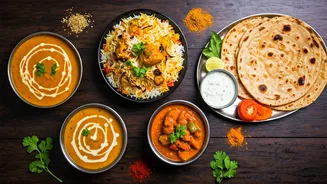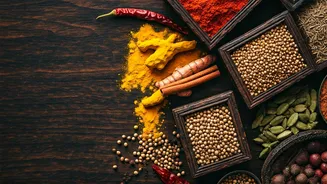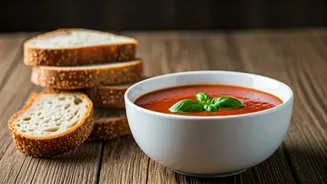Introduction: Culinary Delights
The Mahabharata, an epic tale of war, love, and dharma, also provides a fascinating window into the culinary practices of ancient India. The diet of the characters,
especially the Pandavas and Kauravas, was an essential component of their lives and significantly influenced their well-being. Dishes were designed to nourish and sustain individuals during long journeys, battles, and periods of exile. The recipes used local ingredients and traditional cooking techniques passed down through generations. These dishes weren't just about sustenance; they were an integral part of community life and cultural identity. Several historical accounts and texts provide insights into the foods consumed by these iconic figures, providing a unique perspective into the past. We can recreate these flavors from the Mahabharata by using easily available ingredients and methods.
Khichdi: A Comforting Classic
Khichdi, a staple in Indian cuisine, is a simple yet nutritious dish that likely found its place on the tables of ancient warriors and sages. This one-pot meal, made with rice and lentils, is easy to digest and provides sustained energy, perfect for long journeys or times of stress. The core ingredients usually include rice, such as basmati or sona masuri, and lentils, such as moong dal, masoor dal, or toor dal. Preparing Khichdi involves washing and combining the rice and lentils in a pot, often with water and a pinch of turmeric for color and its anti-inflammatory properties. Variations may include adding vegetables like peas, carrots, and potatoes, or seasoning it with spices like cumin seeds, coriander, and asafoetida. It's often served with ghee and a side of yogurt or pickles, adding a balance of flavors and textures to the meal. Khichdi's simplicity and nutritional value make it an excellent choice for any meal, regardless of the setting or circumstances.
Vegetable Curry: Rich Flavors
Vegetable curry, a dish rich in flavors and colors, would have been an integral part of the Mahabharata-era meals. The availability of diverse vegetables across different regions allowed for a variety of curry preparations. Ingredients would have been based on what was in season, including vegetables like spinach, gourds, beans, and root vegetables like potatoes. The process of making curry generally involved sautéing onions, ginger, and garlic, then adding the vegetables and spices like turmeric, coriander, cumin, and chili powder. A rich, flavorful gravy was often created using coconut milk, tamarind, or yogurt, depending on regional preferences. The dish can be cooked in various ways, from simmering over a slow fire to cooking quickly in a wok. The variety of vegetable curries likely enhanced the daily diet of the Mahabharata characters, providing an assortment of vital nutrients and flavors. This dish also reflects an understanding of the balance needed to maintain both physical health and mental alertness during the challenging times described in the epic.
Dal: Essential Protein Source
Dal (lentils) stands as a crucial part of the diet of the Mahabharata characters, representing a vital source of protein. Several types of lentils, including moong, masoor, and chana dal, would have been used. Preparing dal often involves soaking the lentils to soften them, then simmering them with water and spices until they reach a soft, almost mushy consistency. The use of spices such as turmeric, asafoetida, cumin, and coriander not only adds flavor but also supports the digestive process. A common step includes tempering the dal with hot oil or ghee infused with spices, which releases the flavor of the spices and enhances the overall taste. This method is frequently followed by adding tomatoes, onions, and other ingredients to enrich the taste and texture. Served with rice or roti, dal would have been an integral part of the regular diet, offering necessary nutrients for strength and endurance.
Raita: A Cooling Side
Raita, a cooling side dish made with yogurt, is a delicious addition to a spicy meal. The basic ingredients often include yogurt, vegetables like cucumber or onion, and a blend of spices. Yogurt, the base of raita, has always been a key part of Indian meals due to its probiotic characteristics, making it essential for digestion. The vegetables used in raita can vary, from cucumbers and tomatoes to mint, depending on the season and regional tastes. Spices like roasted cumin, coriander, and chaat masala enhance the taste of raita. Preparing raita is usually straightforward: blend the yogurt with vegetables and spices, ensuring everything is mixed well. Raita's cooling characteristics and flavor balance the spices in other dishes. It offers a refreshing break while helping with digestion, an essential component of a balanced diet, even back in the days of the Mahabharata.
Sweet Rice: Festive Treat
Sweet rice, also known as 'kheer' or 'payasam,' is a traditional dessert often made during festivals and special events. This sweet treat would have been a treat during festivals or celebrations during the Mahabharata era. Sweet rice is generally made by slowly cooking rice in milk, typically with sugar or jaggery to sweeten it. The addition of aromatic spices like cardamom, saffron, and nuts such as cashews and almonds enriches the flavor and texture of the dessert. Cooking methods might vary based on local customs, but the goal is to create a rich, creamy consistency. Sweet rice often symbolizes happiness and abundance, making it an excellent dessert for celebrating life's joyous moments. It signifies hospitality and the sharing of good fortune, making it a delicious and meaningful dish from the Mahabharata era.
